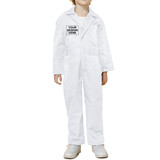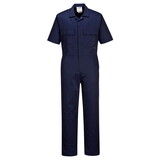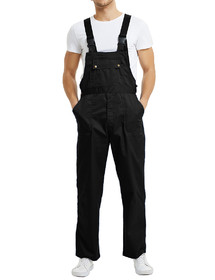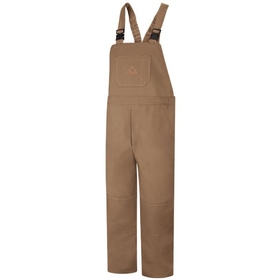Department
- Clothing & Accessories
- Uniforms, Work & Safety
- Work Utility
- Overalls & Coveralls
Brand
- TOPTIE (14)
- Rothco (1)
- Berne Apparel (3)
- Tingley (12)
- Portwest (41)
- Red Kap (16)
- Tough Duck (10)
- Bulwark (42)
- Horace Small (1)
- Big Bill (63)
- Radians (4)
- KleenGuard (3)
- Onguard (1)
- Caddis Wading Systems (1)
- Elbeco (1)
 More
More
Free Shipping
Reviews
Price Group
Material
Age
Sleeve
Fit Style
Lifestyle
Work Coveralls & Overalls
The work coveralls and overalls are the most commonly used work uniform for industrial workers. A high-quality work coveralls should be made of durable, breathable, lightweight fabrics. Good coveralls and overalls are often stain resistant for long-term use in factory and other work environments. Some coveralls also have multiple pockets that are wide enough for workers to access tools at all times. If workers need thick, heat-resistant or highly visible workwear, you can find them here, too.
 Add Your Logo
Add Your Logo
 Wholesale Price
Wholesale Price
 Fast Delivery
Fast Delivery
Custom Coveralls with Logo
See more >>- Sort by
TOPTIE Men's Short-Sleeve Work Coverall Lightweight with Elastic Waist
 81
81
TOPTIE Men's Long Sleeve Coverall, Snap and Zip-Front Coverall Lightweight Work Wear Suit
 68
68
TOPTIE Men's Bib Overall Mid-weight Coverall Big and Tall with Tool Pockets, Workwear...
 21
21
TOPTIE Workwear Mechanic Coverall 8.5 oz Polyester Cotton Blend Size Regular
 12
12
TOPTIE Men's Cotton Blend Zip-Front Work Coverall, Protective Uniform
 102
102
TOPTIE Men's 8.5 oz Front-Zip Long Sleeve Twill Coverall
 16
16
TOPTIE Men's Work Coverall High Visibility Coverall with Reflective Trim
 5
5
TOPTIE Men's Long Sleeve Coverall Action Back Coverall with Zipper Pockets, Mechanic...
 32
32
TOPTIE Short-Sleeve Coverall Enhanced Visibility Striped One Piece Jumpsuit Reflective
 10
10
TOPTIE Men's Short Sleeve Coverall, Workwear Coverall Regular Size
 58
58
TOPTIE Blended Long Sleeve Coverall for Men, Regular Length
 63
63
TOPTIE Men's Reflective Coverall Enhanced Visibility Coverall Short Sleeve with Green...
 10
10
Red Kap CT10-1 Twill Action Back Coverall
 403
403
TOPTIE Men's Twill Action Back Coveralls Zipper Coverall Regular
 31
31
Bulwark Women's Lightweight Excel FR® ComforTouch® Premium Coverall
TOPTIE Men's Long Sleeve High Visibility Coverall with Green Reflective Tape Workwear...
 1
1
Berne Apparel WC262 Women's Highland Flex Cotton Unlined Coverall
Tough Duck WB04 Unlined Premium Duck Bib Overall
Tough Duck WB09 Women’s Duck Insulated Bib Overall
Tough Duck WC01 Insulated Duck Coverall
Big Bill 93 Hickory Stripe Bib Overall with Zip Front Closure
Red Kap BD10DN Utility Bib Overall - Indigo
 1
1
Red Kap BD30 Duck Insulated Bib Overall - 65/35 Polyester / Cotton Duck
Features of Overalls & Coveralls
Overalls and coveralls are similar types of protective workwear, but there are a few key differences.
Overalls typically refer to bib overalls - the classic style with straps that go over the shoulders and a bib in front. Coveralls are jumpsuits that cover the whole body, including the arms. Coveralls provide more full-body protection.
Overalls are often made of lighter, more breathable materials like denim. Coveralls tend to be made of heavier, more durable fabrics suited for demanding work like canvas, polyester or ripstop materials.
Overalls usually have an open back, while most coveralls have an elasticized or drawstring waist to fully enclose the back. Some coveralls also have storm flaps or other closures over their zippers for added protection.
Overalls are a looser, more casual style and often worn for garden work, farm work or casual labor. Coveralls imply a more industrial purpose, like construction, painting, or auto repair.
Overalls typically only have pockets on the bib, while coveralls usually have multiple pockets on the chest, legs, and sleeves to hold tools and supplies.
Suspenders (straps) are optional on overalls but most coveralls do not have suspenders. Coveralls get their shape from the cut and closures alone.
So in summary, while overalls and coveralls are both protective workwear, coveralls tend to provide more full coverage, more technical fabrics, more pockets and a more utilitarian design for heavy-duty work. Overalls are a lighter, looser style for more casual jobs and environments.





















































